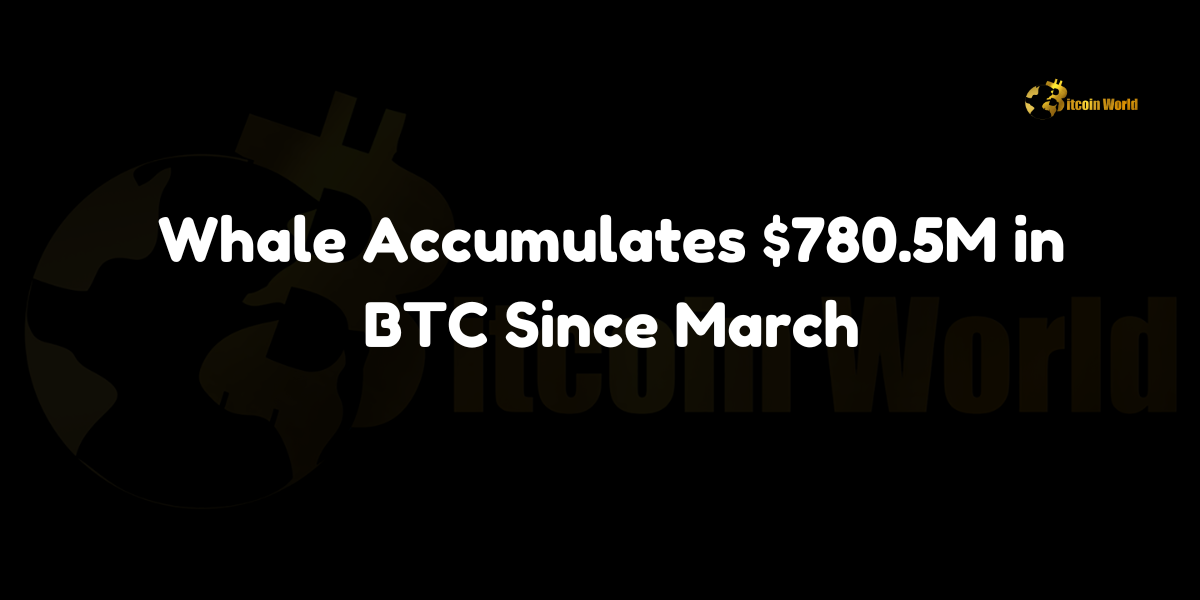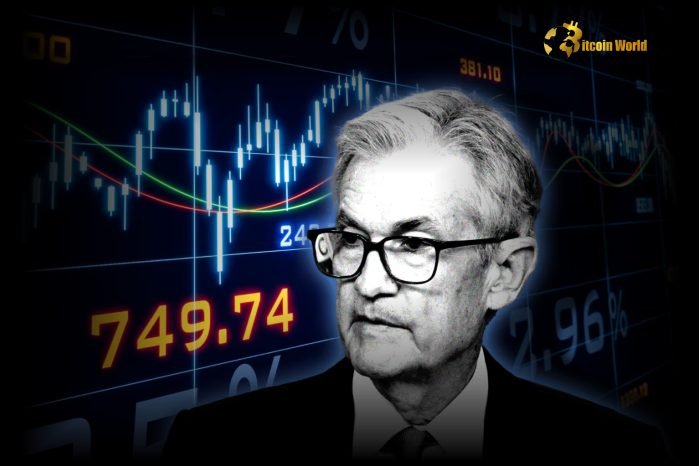Crptocurrency
Whale Accumulates $780.5M in BTC Since March

Whale Accumulates $780.5M in BTC Since March
In a notable display of bullish sentiment, a Bitcoin whale has amassed 11,658 BTC, equating to approximately $780.5 million, since March 14, according to data from blockchain analytics firm Lookonchain. The whale’s strategic accumulation at an average price of $66,953 per coin has resulted in an unrealized profit of $42.3 million as Bitcoin prices have continued to rise.
Introduction to the Whale Accumulation
Who is the Whale?
In the cryptocurrency context, a “whale” refers to an individual or entity holding a large amount of a particular cryptocurrency, in this case, Bitcoin (BTC). While the identity of this particular whale remains anonymous, their significant accumulation of BTC underscores a strong confidence in Bitcoin’s future performance.
Overview of the Accumulation
Since March 14, the whale has systematically purchased 11,658 BTC at an average price of $66,953 per coin. This disciplined buying strategy has allowed the whale to capitalize on Bitcoin’s price volatility, generating a substantial unrealized profit of $42.3 million as of the latest reports.
Detailed Analysis of the Accumulation
Purchase Strategy and Timing
The whale’s accumulation began in mid-March, a period characterized by market volatility and uncertainty. By spreading purchases over several months, the whale likely employed a dollar-cost averaging (DCA) strategy to mitigate the risks associated with sudden price drops and to ensure steady accumulation despite market fluctuations.
Average Purchase Price vs. Current Price
Purchasing BTC at an average of $66,953 per coin indicates the whale’s bullish outlook, anticipating that Bitcoin’s price would continue to appreciate. As Bitcoin’s market price increases, the whale’s position has yielded an impressive $42.3 million in unrealized profits, reflecting a highly successful investment strategy.
Implications for the Bitcoin Market
Market Sentiment and Price Support
Whale accumulations can significantly influence market sentiment. Large purchases by whales can act as a price support, deterring short-term sellers and signaling strong institutional or high-net-worth investor confidence. This behavior can lead to upward price pressure, contributing to Bitcoin’s overall bullish trend.
Liquidity and Market Depth
The infusion of $780.5 million into Bitcoin by a single whale enhances the market’s liquidity and depth. Increased liquidity typically results in reduced price volatility, making the market more attractive to other investors. However, large single transactions can also lead to whale manipulation, potentially causing sudden price spikes or dumps if the whale decides to sell their holdings rapidly.
Impact on Trading Volume
Significant whale activity often correlates with increased trading volumes, as other market participants react to the large accumulations. This can lead to a more active trading environment, providing opportunities for both short-term traders and long-term investors.
Expert Opinions
Dr. Emily Carter, Blockchain Analyst
“The accumulation of 11,658 BTC by a single whale is a clear indicator of strong confidence in Bitcoin’s long-term prospects. This level of investment not only supports the current price but also sets a positive tone for the market, potentially attracting more institutional investors.”
Mark Thompson, Financial Strategist
“Whale accumulations like this one play a crucial role in stabilizing Bitcoin’s price by providing substantial support. However, it’s essential to monitor such activities closely, as the same whales can also exert significant influence when they choose to sell.”
Sarah Lee, Cryptocurrency Researcher
“This large-scale accumulation demonstrates a strategic approach to investing in Bitcoin. By leveraging dollar-cost averaging, the whale minimizes the impact of short-term volatility, positioning themselves for substantial gains as Bitcoin continues to grow.”
Potential Risks and Challenges
Market Manipulation
While whale activities can support Bitcoin’s price, there is always the risk of market manipulation. If the whale decides to offload a significant portion of their holdings suddenly, it could lead to a sharp price decline, impacting the broader market.
Regulatory Scrutiny
Large accumulations of cryptocurrency assets can attract regulatory attention, especially in jurisdictions with strict financial regulations. This whale may face scrutiny regarding the sources of their funds and compliance with anti-money laundering (AML) and know your customer (KYC) regulations.
Volatility and Market Sentiment
Bitcoin’s inherent volatility means that even substantial accumulations can be influenced by sudden changes in market sentiment, macroeconomic factors, or geopolitical events. The whale must remain vigilant and adaptable to navigate these potential challenges effectively.
Future Outlook
Continued Accumulation or Diversification
The whale may continue to accumulate more BTC if their bullish outlook remains intact. Alternatively, they might diversify their portfolio by investing in other cryptocurrencies or digital assets to spread risk and capitalize on emerging market opportunities.
Influence on Bitcoin’s Price Trajectory
This significant accumulation could set a precedent for other large investors, encouraging more substantial investments in Bitcoin. As more whales enter the market, Bitcoin’s price trajectory could see sustained upward momentum, driven by increased institutional interest and mainstream adoption.
Monitoring Whale Activity
Market participants should keep a close eye on the whale’s future activities, as their actions can provide valuable insights into Bitcoin’s potential price movements and overall market health. Tools and platforms that track large transactions and whale movements can offer strategic advantages for traders and investors.
Conclusion
The accumulation of 11,658 BTC by a whale since March 14, resulting in $780.5 million in purchases and an unrealized profit of $42.3 million, is a significant development in the Bitcoin market. This strategic investment highlights a strong confidence in Bitcoin’s long-term growth prospects and contributes positively to the market’s liquidity and stability. However, the influence of such large accumulations also brings potential risks, including market manipulation and regulatory challenges.
As Bitcoin continues to evolve as a major financial asset, the activities of whales like this one will play a pivotal role in shaping its future. Investors and market participants should remain informed and vigilant, leveraging insights from whale movements to inform their own investment strategies.
To stay updated on the latest developments in cryptocurrency investments and market trends, explore our article on latest news, where we cover significant events and their impact on the digital asset ecosystem.
Disclaimer: The information provided is not trading advice, Bitcoinworld.co.in holds no liability for any investments made based on the information provided on this page. We strongly recommend independent research and/or consultation with a qualified professional before making any investment decisions.
Crptocurrency
Ethereum Revenue Boost Expected as Layer-2 Activity Surges

Ethereum Revenue Boost Expected as Layer-2 Activity Surges
Ethereum’s network revenue is poised for a significant revival, driven by the rapid expansion of Layer-2 (L2) networks. In November 2024, L2 solutions like Base, Scroll, and World Chain tripled the transaction data posted to Ethereum’s mainnet compared to March, according to Dune Analytics. This surge in activity underscores the growing adoption of L2 technologies, which aim to increase Ethereum’s scalability and reduce costs, thereby enhancing the user experience and the blockchain’s overall ecosystem.
The boost in L2 network transactions comes at a critical time for Ethereum, as the network is recovering from the impact of the Dencun upgrade, implemented in March 2024. While the upgrade initially led to a notable drop in Ethereum’s revenue due to reduced transaction fees, the resurgence in activity through L2 networks is driving a revenue recovery. Matthew Sigel of VanEck projects that this trend could help Ethereum achieve $66 billion in annual cash flow by 2030, potentially driving the price of ETH up to $22,000. With renewed investor interest following the U.S. presidential election win of Donald Trump, which saw ETH prices rise 10%, Ethereum’s future looks promising as demand for efficient blockchain solutions continues to grow.
Understanding the Role of Layer-2 Networks in Ethereum’s Growth
Layer-2 solutions are scaling technologies built on top of Ethereum’s mainnet, enabling faster and more affordable transactions. By offloading some of the transaction load from the main Ethereum blockchain, these networks significantly reduce congestion and enhance transaction speeds. L2 networks have become a cornerstone of Ethereum’s strategy to address the scalability issues that have long hindered its growth and adoption.
The benefits of L2 networks go beyond speed and cost efficiency. They allow for more sophisticated applications to run on the blockchain, enabling use cases in decentralized finance (DeFi), gaming, and non-fungible tokens (NFTs). As the popularity of these applications increases, so does the demand for a scalable blockchain that can support high transaction volumes without compromising performance. With L2 solutions like Base, Scroll, and World Chain posting record transaction volumes, Ethereum’s scalability efforts appear to be paying off.
Ethereum’s Dencun Upgrade: A Double-Edged Sword
The Dencun upgrade, deployed in March 2024, introduced a range of improvements aimed at enhancing Ethereum’s efficiency and reducing transaction fees. However, these changes initially led to a drop in Ethereum’s network revenue, as transaction fees constitute a substantial portion of its earnings. Lower fees, while beneficial for users, resulted in a temporary revenue slump for the network.
Now, as L2 solutions drive transaction volumes back up, Ethereum is beginning to recover from this initial setback. The combined effect of lower fees and increased transaction volumes could yield a more sustainable revenue model, balancing affordability for users with profitability for the network. As L2 adoption accelerates, Ethereum’s revenue model could shift towards one that prioritizes transaction volume over fee structure, a change that would align well with the broader goals of blockchain scalability and accessibility.
Projected Revenue and Market Value: What’s Next for Ethereum?
The increased activity on Ethereum’s L2 networks has sparked renewed optimism among investors and analysts. According to VanEck’s Matthew Sigel, Ethereum’s annual cash flow could reach an impressive $66 billion by 2030. This projection assumes continued adoption of L2 solutions, as well as the sustained growth of decentralized applications (dApps) and DeFi platforms. Sigel’s analysis also indicates that this increased revenue potential could drive the price of ETH to approximately $22,000 over the next six years.
These projections reflect Ethereum’s potential to become a dominant force in the blockchain space, particularly as the network transitions to a more scalable and efficient model. For investors, Ethereum’s future revenue potential represents an opportunity to capitalize on the platform’s growth, as the blockchain continues to establish itself as the backbone of the decentralized internet.
The Impact of the U.S. Presidential Election on Ethereum and Crypto Markets
The recent U.S. presidential election, which saw Donald Trump winning a second term, has had a notable impact on the crypto market. Following the election, ETH prices surged by 10%, with Ether-based ETFs in the U.S. witnessing $52.3 million in net inflows. This trend suggests a renewed interest in cryptocurrency investments, as investors seek alternatives to traditional assets amid potential economic uncertainty.
Trump’s re-election has led to speculation around potential changes in regulatory policies that could either support or hinder the growth of the crypto industry. For Ethereum and other major cryptocurrencies, a more favorable regulatory environment could lead to increased institutional adoption, driving demand and potentially pushing prices higher. Conversely, restrictive policies could create challenges for the industry, though the resilience of blockchain technology and decentralized finance would likely persist.
The influx of investment into U.S. spot Ether ETFs highlights a shift in investor sentiment, with many viewing cryptocurrencies as a viable long-term asset class. This renewed interest in Ethereum and the broader crypto market signals a growing recognition of digital assets as an integral part of modern finance.
Challenges and Opportunities Ahead for Ethereum
While the outlook for Ethereum appears promising, several challenges remain. Scalability, security, and regulatory concerns continue to pose risks to the network’s growth. Although L2 solutions offer a temporary fix for scalability, further upgrades and innovations will be needed to sustain long-term growth. The Ethereum community is actively working on future updates to address these issues, including the anticipated “Shard Chains” upgrade, which aims to further enhance Ethereum’s scalability by splitting the blockchain into multiple “shards” that can process transactions in parallel.
In addition to technical challenges, Ethereum faces increasing competition from other blockchain networks that offer similar functionality with potentially greater scalability or lower fees. Projects like Solana, Polkadot, and Cardano are rapidly evolving and could pose a threat to Ethereum’s dominance in the smart contract and dApp ecosystem. However, Ethereum’s first-mover advantage, combined with its active developer community and widespread adoption, provides it with a strong foundation to maintain its position in the market.
Conclusion
Ethereum’s projected revenue growth, driven by the surge in Layer-2 network activity, paints an optimistic picture for the blockchain’s future. As L2 networks like Base, Scroll, and World Chain drive up transaction volumes, Ethereum is beginning to recover from the revenue slump experienced post-Dencun upgrade. With projections of $66 billion in annual cash flow by 2030 and a potential ETH price of $22,000, Ethereum is positioning itself as a key player in the evolving digital economy.
The recent spike in ETH prices following the U.S. presidential election and the inflow of funds into Ether ETFs underscore the growing interest in crypto assets as viable investments. However, Ethereum must navigate several challenges, including scalability and competition, to maintain its growth trajectory. As the Ethereum network continues to evolve and adapt to the demands of a rapidly changing landscape, it has the potential to redefine the future of decentralized finance and the broader blockchain industry.
To learn more about the innovative startups shaping the future of the crypto industry, explore our article on the latest news, where we delve into the most promising ventures and their potential to disrupt traditional industries.
Crptocurrency
Invest $500 in These High-Growth Altcoins and Secure a $2 Million Crypto Portfolio by 2025

Crptocurrency
Fed Cuts Interest Rate by 25 Basis Points, Aligns with Market Predictions

-

 Startup Stories1 year ago
Startup Stories1 year agoWhy Millennials, GenZs Are Riding The Investment Tech Wave In India
-

 Startup Stories1 year ago
Startup Stories1 year agoStartups That Caught Our Eyes In September 2023
-

 Startup Stories1 year ago
Startup Stories1 year agoHow Raaho Is Using Tech To Transform India’s Fragmented Commercial Trucking
-

 Startup Stories1 year ago
Startup Stories1 year agoMeet The 10 Indian Startup Gems In The Indian Jewellery Industry’s Crown
-

 Crptocurrency8 months ago
Crptocurrency8 months agoLither is Making Crypto Safe, Fun, and Profitable for Everyone!
-

 Startup Stories1 year ago
Startup Stories1 year agoHow Volt Money Is Unlocking The Value Of Mutual Funds With Secured Lending
-

 E-commerce1 year ago
E-commerce1 year agoTop Online Couponing Trends To Watch Out For In 2016
-

 Startup Stories1 year ago
Startup Stories1 year agoWhy Moscow-Based Kladana Considers Indian SME Sector As The Next Big Market For Cloud Computing




